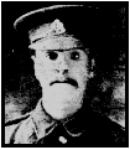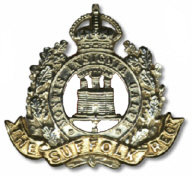




No.7977, Lance Sergeant, Walter Edward BROWN
Aged 23

|
Walter Edward Brown was born in Soham on 28th February 1893 (Newmarket Q2-1893 3B:545), baptised in Soham on 20th May 1903, son of William James and Elizabeth BROWN
(née BARTLE) of Granby Terrace, Soham.
1901 census...Aged 8, he was at Granby Terrace, Soham with his father William James BROWN [35] brewer's agent; his mother Elizabeth [37] born Barnham, Suffolk; brothers Charles W [12] and Robert [11]; sisters Harriett[10] and Ethel E [1]. All except his mother were born in Soham. 1911 census...Aged 19, he was a private in the 2nd battalion, Suffolk Regiment at Aldershot. His parents were at Hall Street (Granby Terrace), Soham with his brother Benjamin George [9] and sisters Ethel Emma and Kate Elizabeth [5]. 3 of Elizabeth's 9 children had died. His elder brother Robert died in 1917 in France. see here |

|
He enlisted in Ely. As a regular in the Army he was of course one of the first to be sent to France and unfortunately he was one of the first Soham men to die. His Army records have not survived. The 2nd Battalion were in Dublin on the day war broke out, 4th August 1914, and by 10th they were ready to embark direct to France. Moving by marching and by train they eventually reached Mons on the 22nd. Then the German advance strengthened and the Retreat from Mons began for the British Army. By the evening of the 25th August the 2nd Suffolks were halted just outside Montay. After a brief halt they moved on, to Pont des Quatre Vaux, half a mile west of Le Cateau. On the 26th the order went out from Brigadier General Rolt that there was to be "no retreat...there is to be no thought of retirement". After six hours of continuous and overwhelming fire, they still held, but the Germans had mustered an massive force which nearly totally surrounded the British and by just before 3 the Argyll Highlanders and the Suffolks were overcome. A battalion in the British army was approximately 1,000 men and this day the 2nd Suffolks suffered 720 casualties of all ranks. The remnants slipped away and the next day, at dawn the roll call revealed the Battalion under command of Lt Oakes was 'A' Coy 31; 'B' Coy 19; 'C' Coy 38 and 'D' Coy 16 with 7 attached men, a total of 111. A few stragglers caught up later in the day. The dead numbered 74, only three have known graves. Numbers at this stage of the war are notoriously inaccurate. The Imperial War Graves Commission had not even been thought of. In fact the concept of even finding the dead and burying them individually was not generally known. Up to then it would have normally only been some officers buried individually or brought back to England. It took a man called Fabian Ware to start organising the currently accepted method of recording, and burying the dead, where possible, in individual graves.
click here to go to the Commonwealth War Graves Commission website for full cemetery/memorial details |